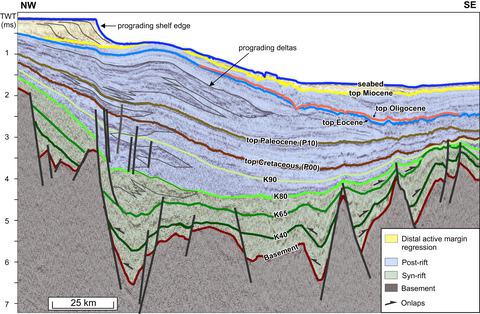当前位置:
X-MOL 学术
›
Basin Res.
›
论文详情
Our official English website, www.x-mol.net, welcomes your feedback! (Note: you will need to create a separate account there.)
Evolution of syn- to early post-rift facies in rift basins: insights from the Cretaceous–Paleocene of the Great South Basin, New Zealand
Basin Research ( IF 3.2 ) Pub Date : 2021-12-28 , DOI: 10.1111/bre.12652 Tusar R. Sahoo 1, 2 , Dominic P. Strogen 2 , Greg H. Browne 2 , Andrew Nicol 1
Basin Research ( IF 3.2 ) Pub Date : 2021-12-28 , DOI: 10.1111/bre.12652 Tusar R. Sahoo 1, 2 , Dominic P. Strogen 2 , Greg H. Browne 2 , Andrew Nicol 1
Affiliation

|
Evolution of rift basin fill and geometry depend on the complex interactions between fault growth, sediment supply, base level changes and pre-existing basement fabric. This study integrates multiple datasets in the Great South Basin (GSB), southeast New Zealand, and provides key insights into the evolution of depositional environments in rift basins, including the interplay between normal faulting, sediment supply and sediment dispersal patterns. It also examines the control of pre-existing basement fabric on rift geometry and sediment distribution in the syn- and post rift successions. The syn-rift is up to ~5.5 km thick in the GSB, and is underlain by several different basement terranes. Three syn-rift stages are recognised; c.105–101, 101–90 and 90–83 Ma. During the initial syn-rift, isolated northeast-trending graben developed, with resultant alluvial fan/fan delta, fluvial, coastal and lacustrine sediment fill. The balance between sediment supply and accommodation space exerted considerable control on facies, especially the presence of lacustrine facies. During the later stages of syn-rift, marine transgression occurred and connectivity between the graben developed, with shelfal, shoreface and marginal-marine facies deposited. With marine transgression across the hinterland, sediment supply was significantly reduced in the northeast of the basin, leading to underfilling of graben, and preservation of rift topography for up to ~20 Myr after the cessation of faulting. In the west, where sediment supply was higher, rift topography was quickly filled. The NW-trending basement terrane boundaries controlled accommodation space development during the initial stages of graben formation. Later in the syn- and post rift stages, these terrane boundaries formed long-lived sediment input points into the basin, and controlled the position of repeated large deltaic depositional units.
中文翻译:

裂谷盆地同相至裂后早期相的演化:来自新西兰大南盆地白垩纪-古新世的见解
裂谷盆地填充物和几何形状的演变取决于断层生长、沉积物供应、基础水平变化和预先存在的基底结构之间的复杂相互作用。这项研究整合了新西兰东南部大南盆地 (GSB) 的多个数据集,并为裂谷盆地沉积环境的演变提供了重要见解,包括正常断层、沉积物供应和沉积物扩散模式之间的相互作用。它还检查了预先存在的基底结构对裂谷几何形状和同裂谷序列和裂谷后序列中沉积物分布的控制。GSB 中的同裂谷厚达约 5.5 公里,其下方是几个不同的地下地体。识别出三个同裂谷阶段;c.105–101、101–90 和 90–83 Ma。在最初的同向裂谷中,孤立的东北向地堑发育,形成冲积扇/扇三角洲、河流、海岸和湖泊沉积物填充物。沉积物供应和容纳空间的平衡对相,特别是湖相的存在具有相当大的控制作用。同裂陷后期发生海侵,地堑之间的连通性发育,陆架相、滨海相和边缘海相沉积。随着海侵穿越腹地,盆地东北部的沉积物供应显着减少,导致地堑充填不足,断陷停止后裂谷地形可保存约 20 Myr。在沉积物供应较高的西部,裂谷地形迅速被填满。地堑形成初期,NW 向的基底地体边界控制了可容纳空间的发展。在同裂谷后期和裂谷后阶段,这些地体边界形成了进入盆地的长寿命沉积物输入点,并控制了重复的大型三角洲沉积单元的位置。
更新日期:2021-12-28
中文翻译:

裂谷盆地同相至裂后早期相的演化:来自新西兰大南盆地白垩纪-古新世的见解
裂谷盆地填充物和几何形状的演变取决于断层生长、沉积物供应、基础水平变化和预先存在的基底结构之间的复杂相互作用。这项研究整合了新西兰东南部大南盆地 (GSB) 的多个数据集,并为裂谷盆地沉积环境的演变提供了重要见解,包括正常断层、沉积物供应和沉积物扩散模式之间的相互作用。它还检查了预先存在的基底结构对裂谷几何形状和同裂谷序列和裂谷后序列中沉积物分布的控制。GSB 中的同裂谷厚达约 5.5 公里,其下方是几个不同的地下地体。识别出三个同裂谷阶段;c.105–101、101–90 和 90–83 Ma。在最初的同向裂谷中,孤立的东北向地堑发育,形成冲积扇/扇三角洲、河流、海岸和湖泊沉积物填充物。沉积物供应和容纳空间的平衡对相,特别是湖相的存在具有相当大的控制作用。同裂陷后期发生海侵,地堑之间的连通性发育,陆架相、滨海相和边缘海相沉积。随着海侵穿越腹地,盆地东北部的沉积物供应显着减少,导致地堑充填不足,断陷停止后裂谷地形可保存约 20 Myr。在沉积物供应较高的西部,裂谷地形迅速被填满。地堑形成初期,NW 向的基底地体边界控制了可容纳空间的发展。在同裂谷后期和裂谷后阶段,这些地体边界形成了进入盆地的长寿命沉积物输入点,并控制了重复的大型三角洲沉积单元的位置。


























 京公网安备 11010802027423号
京公网安备 11010802027423号